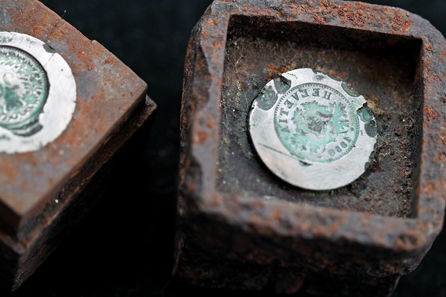by Björn Schöpe
November 7, 2013 – In the 1870s the Swiss Cantonal Bank of Valais experienced a crisis after a serious row of bad speculations. (You must bear in mind that at the epoch people lacked certain experiences we have made in the meantime, so today this could, of course, not happen any more …) The inhabitants of the Valais therefore had not much confidence in paper money issued by the Bank. They preferred coins – even though they were forged. This psychological starting situation came in handy for a cunning Italian forger who had flown from his native country into the impenetrable valleys of southern Switzerland evading thus police: Joseph-Samuel Farinet.
This painting might portrait Farinet, it turned up in 2007. Photo: Amis de Farinet / http://creativecommons.org/licenses/by-sa/3.0/deed.en.
Farinet was born son to a blacksmith in the Aosta Valley in 1845 a fact which may have favoured his coining talents. Anyway, he was productive in the Valais for quite a long period.
Salle Farinet, Musée de la Fausse Monnaie in Saillon. © Yannick Broccard.
His forged coins are said to be excellent and he is often compared with Robin Hood. However, his donations to the poor probably were not without ulterior motives:
Salle Farinet, Musée de la Fausse Monnaie in Saillon. © Yannick Broccard.
In the end he needed help not only with the production (personally he used to make only the dies while others made the coins in various hidden places) but also a broad solidarity among the population. Thanks to that he would move quite freely and without fearing the authorities. Nevertheless having been jailed a couple of times he always succeeded in escaping – among others he was supported by one of his many mistresses. In the course of a decade reportedly the 20 Rappen pieces which had become his speciality and were thus called also ‘Farinets’ after their maker constituted about one third of all coins circulating in the Valais!
Salentse Valley nearby Saillon where Farinet died. Photo: Willi Wottreng / http://creativecommons.org/licenses/by-sa/3.0/deed.en.
In 1880 eventually the popular hero came to a bad end: when Farinet tried to escape police closed him in and he fell into a river dying. Until today the opinion persists, though, that Farinet did not die by accident but was rather shot voluntarily by the police.
Salle Farinet, Musée de la Fausse Monnaie in Saillon. © Yannick Broccard.
As with his English equivalent Robin Hood just after Farinet’s mysterious death he started to become a true legend. In the 1930s a book and a film of his life were successful and today one may still see numerous intriguing objects concerning the forger’s life and numismatic products in the local forgery museum.
This slab indicates the world’s smallest vineyard measuring 1.618 square metres and gives its current owner, the Dalai Lama. Photo: Ludovic Péron / http://creativecommons.org/licenses/by-sa/3.0/deed.en.
In 1980, in occasion of Farinet’s hundredth birthday a group which called themselves ‘Farinet’s Friends’ contrived something that might well have delighted their idol. They acquired a vineyard lot nearby Saillon where their hero is buried, measuring some 1.6 square metres making it thus the arguably smallest vine yard in the world. The wine is stretched out as a cuvée with other wines up to the quantity sufficient for 1,000 bottles. These bottles are sold at high price donating the proceeds to charity. Many vips like Claudia Cardinale or Zinedine Zidane have assisted at the vintage. The first honorary owner of the Farinet vineyard was one of the founders of ‘Farinet’s Friends’, Jean-Louis Barrault, the very actor who represented the forger in the 1938 movie. When he died in 1994, this honour was awarded to the famous Pierre Abbé, in 1999 the Dalai Lama succeeded him.
The smallest vineyard of the world is also the last station of a walking route in memory of Farinet. The route starts at Place Farinet, a small car park down the valley, meandering up over three kilometres to the vineyard in Saillon.
The first stained-glass panel of the Sentier des Vitraux: Invitation. © SD Saillon.
Twenty-one glass-stained panels on vertical steel beams speak of aspects of Farinet’s life which, at the same time, address everybody with the universality of the topics: invitation, love, silence, friendship, death, immortality. The panels are made of glass – that is why the route took the name Sentier des Vitraux or ‘Route of the glass sculptures’ – are a real feast for the eyes. They weigh between a couple of hundreds of kilo and a whole ton! Théo Imboden made these sparkling glass tableaus after woodblock print models crafted by artist Robert Héritier.
The last panel of the walking route Sentier des Vitraux: Immortality. © SD Saillon.
Walking Farinet’s trail does not only mean to experience a fascinating piece of Swiss history – because indeed Farinet’s success during his lifetime speaks quite eloquently of the headstrong inhabitants of the Valais – and remembering a numismatic curiosity which has nearly fallen into oblivion outside of the Valais. Hikers may also feel inspired to reflect over themselves and life in general. And where one could do this better than on route to the grapes of the Dalai Lama …?
Tourists will find many information on Farinet’s trail here.
The town of Saillon presents also these artistic glass panels …
… and the smallest vineyard of the world.
‘Farinet’s Friends’ have their own website.
And even Farinet himself lives on in a blog.










